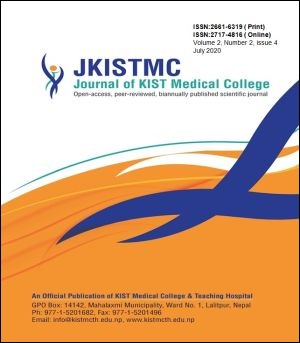Outcome of Titanium Elastic Nailing in the Surgical Management of Femoral-Shaft Fracture in Children
DOI:
https://doi.org/10.3126/jkistmc.v2i2.33755Keywords:
Femoral shaft fractures, Pediatric fracture, Titanium Elastic NailingAbstract
Introduction: Femoral shaft fracture is one of the most common orthopedic injuries of the children. These fractures treated non-operatively by traction followed by hip spica require prolonged hospitalization causing undue physical and psychological stress for patient and patient family. Loss of reduction is also commonly seen with hip spica that leads to unacceptable complications like angular deformities and limb length discrepancies. Titanium Elastic Nailing (TEN) is becoming widely accepted treatment for femoral shaft fractures in children due to its simplicity and physeal protective stable load sharing construct that allows early mobilization. The purpose of this study was to see the outcome of operative treatment of femoral shaft fracture in children by TEN.
Methods: A retrospective observational study was carried out in the Department of Orthopedics in National Academy of Medical Sciences, National Trauma Center from February 2017 to January 2019. Study was undertaken in 22 children between the age group of 5-14 years with femoral shaft fractures. Fixation with TEN was done for all fractures within nine days of injury. Patients were assessed radiologically as well as clinically until fractures healed. The results were evaluated using Flynn scoring criteria.
Results: Radiological union was seen in all cases between 6–12 weeks after surgery. The mean operating time was 58 (48-115) minute and mean hospital stay after surgery was 9 (6-15) days. Results were excellent in 14 patients (63.63%), satisfactory in 6 patients (27.37%) & poor in 2 patients (9%). Six patients had skin irritation at nail insertion site which resolved after removal of nails. Functional range of motion in both hip and knee joints of affected limb was preserved in all cases after the removal of nails.
Conclusion: TEN is an effective and safe treatment of femoral shaft fractures in children of 5-14 years of age group.

